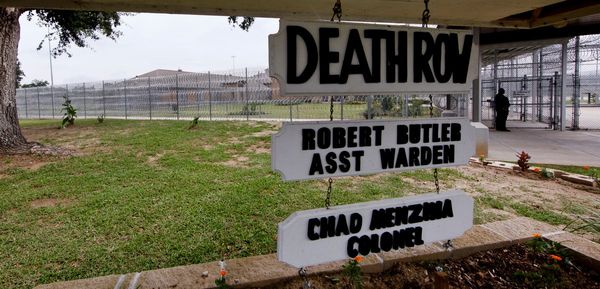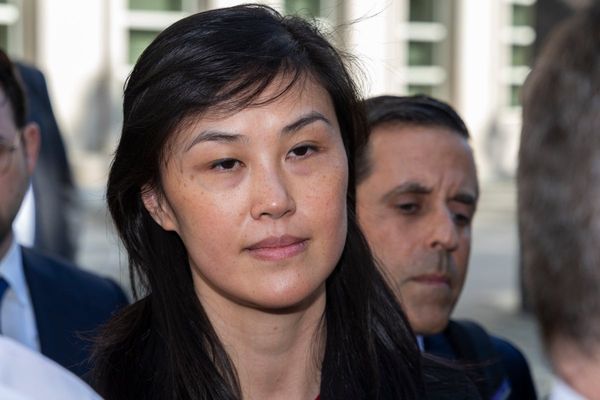
‘Are you sure?” a man ascending the stairs asks before I venture down into Arles’ ancient cryptoporticus. At the bottom awaits Sophie Calle’s exhibition Neither Give or Throw Away. It’s one of the headline shows of this year’s Rencontres d’Arles photography festival, but I understand what the concerned passerby means. It’s spooky down here in the subterranean chambers, where the semi-dark is permeated only by the stagnant scent of underground damp, and pools of sepia water collect on the dirt floor.
I’ve walked into a funeral for photographs – a final farewell for Calle’s ill-fated series The Blind, when the French artist interviewed people attending an institute for the blind in Paris in 1986. She interviewed 23 individuals of all ages, and the series is composed of Calle’s haunting closeup photo portraits of them, with collections of photographs of the things they describe in text extracts as beautiful – the sea, leopard fur, the colour white, hair, their homes, their mothers. It’s a poetic and, at times, harrowing rumination on vision, and how images are constructed in the mind. But in 2023, the works were damaged after a storm hit Calle’s storeroom, and they became infested with mould spores. So this – at least according to Calle – is to be their final resting place, along with some other works she wasn’t sure what to do with. But in case you’re thinking of taking anything – as the title implies – don’t bother. As Calle warns in an introductory statement: they’re toxic.
It’s a bracing beginning for this year’s edition of the world-famed photo festival, opening just as France enters a new political chapter. What we are has a huge impact on what we see – and this is explored in existential ecstasy across Arles. A giant floating cucumber and colossal cauliflowers turn out to be an AI-generated historical fiction about the Green revolution by Bruce Eesly, that eventually becomes too absurd to believe , yet leaves you considering the veracity of any visual account taken as fact. In the ecclesiastical setting of the Saint Trophime cloisters, a pair of prismatic panelled panoramas, with gorgeous gradients that change as you move past them, are in fact recordings of sunrise and sunset on high seas in the Arctic, Indian and Pacific Oceans and the Mediterranean Sea. They were taken by sailors and navigators according to strict instructions laid out by artist Mustapha Azeroual and curator Marjolaine Lévy. These benevolent abstract images belie a dark political undertow: a chromatic call to arms about the degradation of the seas and skies, the colours the result of human activity on Earth.
Elsewhere, a wounded civilian sits on the ground in tattered clothing; the remains of the flesh of his left leg poke out of torn trousers, apparently blown off. Nearby a soldier poses with a grisly facial wound. It turns out it is all part of an elaborate simulation of warfare, documented by Harvard-trained human rights lawyer Debi Cornwall at army bases across the US. The relief when you discover they are not real is short-lived. This realistic role-play walks a razor-thin line. Many of these bases employ real refugees from Iraq and Afghanistan to reenact versions of themselves in these mock Middle Eastern landscapes to help American soldiers train for combat.
There’s a lot of very niche stuff here, some good, some less so. I couldn’t get enough of Rajesh Vora’s glorious documents of the doozy sculptures that sit atop homes in villages across the Punjab, each creation more wild and entertaining than the next. A photographic paean to the short-lived history of the railway dining carriage, and another devoted to the Provençal pastime of petanque, are whimsical and nostalgic, but I find both too on-the-nose to feel there’s much more to them than seductive gimmick. A show about vampires in a church sounds promising: but the exploration of “tropical goth”, the visual culture of El Grupo de Cali, a Colombian gang active in the 1970s and 1980s, feels disjointed, from a strange video of a 13-year-old’s birthday party, to flashmobs dancing to Thriller, to portraits of disfranchised prostitutes. It is disappointing, too, that this is the only major representation of Latin American artists at Arles this year.
As with most festivals, it’s the unknown acts that unexpectedly steal the show: pass the fruit and veg aisle and duck between the women’s underwear at retail chain Monoprix to find the Louis Roederer Foundation 2024 Discovery award shortlist exhibition, On the Lookout. Loosely themed around “disquiet”, each artist expresses disillusionment and anxiety about what comes next in the world in evocative ways.
Nanténé Traoré’s works are physically and conceptually porous, printed on plexiglass and transparent fabric, ambient, indistinct murmurs that are hard to read. An entirely different atmosphere is created by Tshepiso Mazibuko – the only African woman included in this year’s official programme, which is a travesty. Mazibuko’s series borrows from a Sesotho proverb – To Believe in Something That Will Never Happen – and focuses on young people and children in the first established Black township of Thokoza, near Johannesburg, where the artist lives. These young Black people, like the artist, belong to the born-free generation – but as Mazibuko’s empathetic documents show, their circumstances are still difficult and full of dashed hopes. Using motifs of homes, streets and clothes that are insalubrious, stained and wounded, Mazibuko’s body of work is an indictment of the romanticised view of post-apartheid freedom and a testament to the bittersweet perseverance of youth in unequal times.
The winner of the Discovery award 2024 is François Bellabas’s project An Electronic Legacy, which began in 2016 when the artist found himself in the middle of a wildfire in California. He captured the burning landscape and charred skies on camera, and later fed 5,000 of his images to GAN, a first-generation AI. In 2023, he used the images from that database to create a tracking shot with ChatGPT, Dall-E and Mid-Journey. Images from all three periods of the work are arranged in a riveting installation that dovetails the hot-button topics of climate change, AI and the failure of the American dream.
Elsewhere across the city, highlights include an ambitious, groundbreaking group show of 26 Japanese women photographers working between the 1950s and today, born between 1899 and 1987, a period in which Japan has experienced immense change but in which the gender gap has hardly narrowed. I’m So Happy You’re Here is possibly too crammed with artists and themes to give enough space to each, but it’s nonetheless a vital reminder of how women have shaped the medium in Japan through the postwar period and beyond.
Many of the artists deal with the socio-political concerns of women in a society that last year dropped in ranking to its worst-ever position in the Global Gender Gap report. Nagashima Yurie – one of Japan’s leading activist artists – literally sticks a middle finger up at the patriarchy in her punchy, provocative nude and semi-nude portraits of herself pregnant, and later with her family, in the 1980s and 1990s. As she puts it: “When you have a camera on a tripod, you have the space in front of the camera and also the space behind the camera. It’s very symbolic. It’s a way of taking action against the historical roles of the male and the female in photography.”
These are juxtaposed with quieter subversions, such as Ushioda Tokuko’s fastidious documents of her everyday life at home – from the old fridge her husband surprised her with that once belonged to American soldiers, to the little feet of her daughter, sticking up delightedly from a pile of sheets, these images tease out a sense of oppression in a subtle way. Photographing domestic things that have meaning and importance to the artist is her way of aggrandising them, of giving them a life that’s bigger than the space they are permitted.
A final unmissable moment at Arles is Mo Yi’s Me in My Landscape, the first survey of the remarkable yet little known Chinese artist’s work. It features 150 contemplative and captivating photographs that showcase the brazen inventiveness of an outsider. Mo Yi was a professional footballer for a decade, who worked for a time as a photographer at a children’s hospital in Tianjin and later trained in meditation. Much of his work is influenced by the rupture he experienced when his family relocated from a rural Tibetan diasporic community in Shaanxi Province to the city of Tianjin after the Cultural Revolution.
Against the backdrop of an expanding, bustling, rapidly developing cityscape, Mo Yi comes in and out of the frame, scruffily dressed, his presence interrupting the slick and sleek pace of modern life. Struggling to situate himself against the McDonald’s, box fresh sneakers and heaving intersections, the world around Mo Yi becomes shinier and newer as he becomes older, and a stranger in his home.
In the series I am a Street Dog, (1995), Mo Yi attached his camera to the end of a stick and walked around the city, shooting via a remote shutter button to give a dog’s eye view. Another time he attached his Minolta to the back of his neck, his chest or his arm to take pictures on the streets or on the bus – getting closer to the experience of looking and being than constructing and composing frames. Consistently experimental and with an anarchic character, Mo Yi turns the camera from a vehicle of modernism into a complicit companion. In one image, a meditating Mo simply stands in the middle of the frame, serene, eyes closed, as the traffic rushes by behind him. It reminds me of Kafka’s suggestion, that perhaps we photograph things to drive them out of our minds. Then I take out my phone, and take a picture of it.







